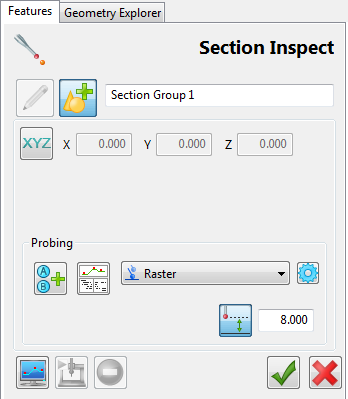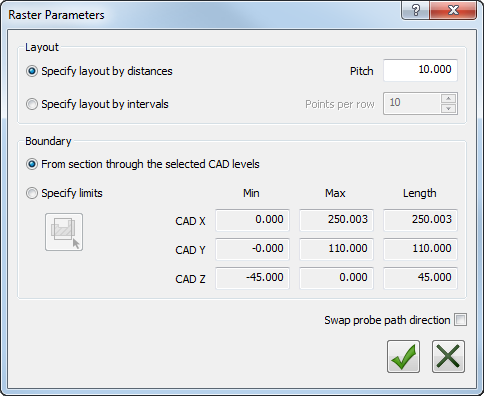Use a CNC Section Group to measure cross-sections through a part by following a probe path. To create a CNC Section Group, you must specify the plane along which the part must be probed, then specify the details of the probe path to be used.
To create the probe path for a CNC Section Group:
- In the Features tab, deselect the Generate Probe Path button.
- Click Hometab > Create panel > Form > CNC Section Group. A section group is added to the inspection sequence, and the Section Inspect dialog is displayed in the
Features tab.

- In the inspection sequence, double-click the group's name. The Section dialog is displayed.
- In the
Section dialog:
- Use the Cut Plane area to specify the location of the section on the part.
- To use CAD levels to control the area of the part to be probed, select the Use custom levels check box, and click Levels to specify the levels.
- Click OK to save your changes and close the dialog.
- In the
Section Inspect dialog:
- Select the AutoTouchTrigger probing method of Raster in the Probing method list.
- Click the
Parameters
 button. The
Raster Parameters dialog is displayed.
button. The
Raster Parameters dialog is displayed.

- In the
Raster Parameters dialog, choose a
Layout method for the probe path. To specify the:
distance between each point on the section, select Specify layout by distances and enter a Pitch value.
- number of points to be probed along the section, select Specify layout by intervals and enter a Points per row value.
To reverse the direction of the probe path, select the Swap probe path direction check box.
- In the
Boundary area, specify the extent of the probe path. Select:
- From section through the selected CAD levels to restrict the probe path to the CAD levels selected in the Custom levels area of the Section dialog. If no custom levels are specified in the dialog, PowerInspect uses the active levels specified in the CAD tab.
- Specify limits to restrict the probe path to specified boundaries. To specify the boundaries, enter the
Min,
Max, and
Length values for the probe path in each major axis of the CAD model. Alternatively, click the
Edit Graphically
 button and use the box displayed in the CAD view to restrict the path boundaries. When you click
button and use the box displayed in the CAD view to restrict the path boundaries. When you click
 , the Edit Boundary dialog opens and a box is displayed around the model in the CAD view.To move the box, left-click and hold a yellow line, drag the box to its new position, then release the mouse button.To change the size of the box, left-click and hold a blue line, drag the line to its new position, then release the mouse button. For example:
, the Edit Boundary dialog opens and a box is displayed around the model in the CAD view.To move the box, left-click and hold a yellow line, drag the box to its new position, then release the mouse button.To change the size of the box, left-click and hold a blue line, drag the line to its new position, then release the mouse button. For example:

The positions and sizes of the boundaries are displayed in the Edit Boundary dialog, and the position and extent of the probe path is shown in green. Any points outside the boundaries are excluded from the probe path.To adjust the shading of the cut plane, move the Opacity slider in the Edit Boundary dialog.
- Click
 to save your changes and close the
Raster Parameters dialog.
to save your changes and close the
Raster Parameters dialog.
- In the
Section Inspect dialog, click
 to save your changes. The probe path of the section is displayed in the CAD view, and you can now run the item as part of the inspection sequence.
to save your changes. The probe path of the section is displayed in the CAD view, and you can now run the item as part of the inspection sequence.
To edit the probe path of a CNC Section group:
- In the inspection sequence, select the group.
- In the
Section Inspect
dialog, click the
Reuse
 button.
button.
- In the Probing method list, select a
UserDefined probing method to activate the Probe Path Editor.
PowerInspect converts the points to guided surface points and displays them in the inspection sequence.
Guided surface points enable you to measure the same point in each Measure of a document.
- Adjust the probe path using the Probe Path Editor.
- Click
 to save your changes.
to save your changes.
You can now run the item as part of the inspection sequence.